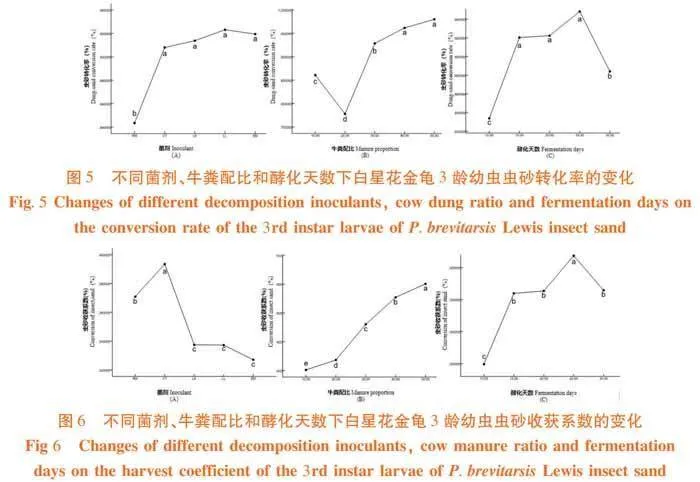
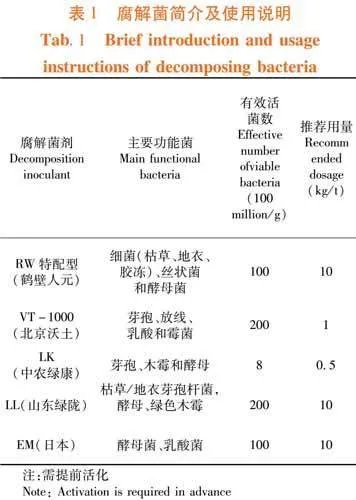
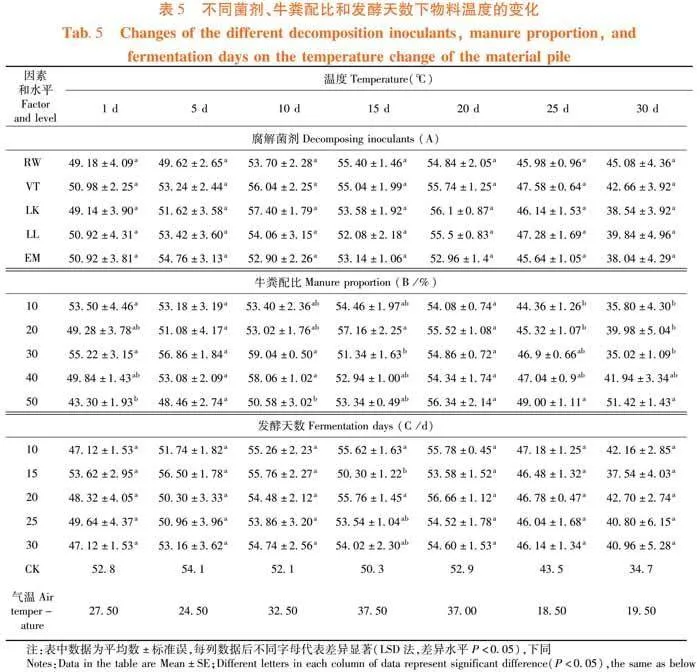

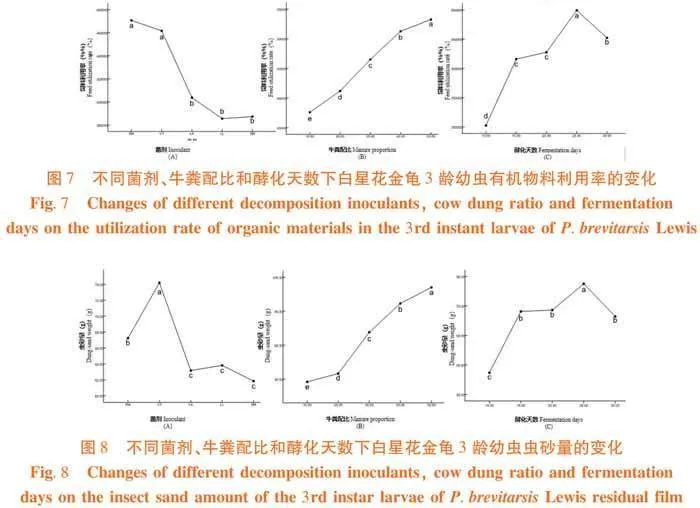
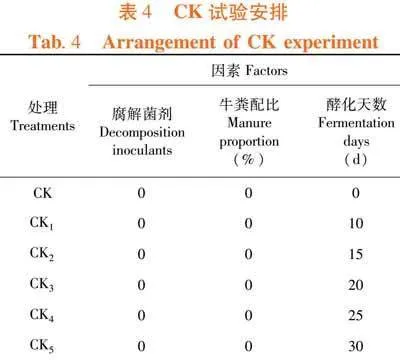


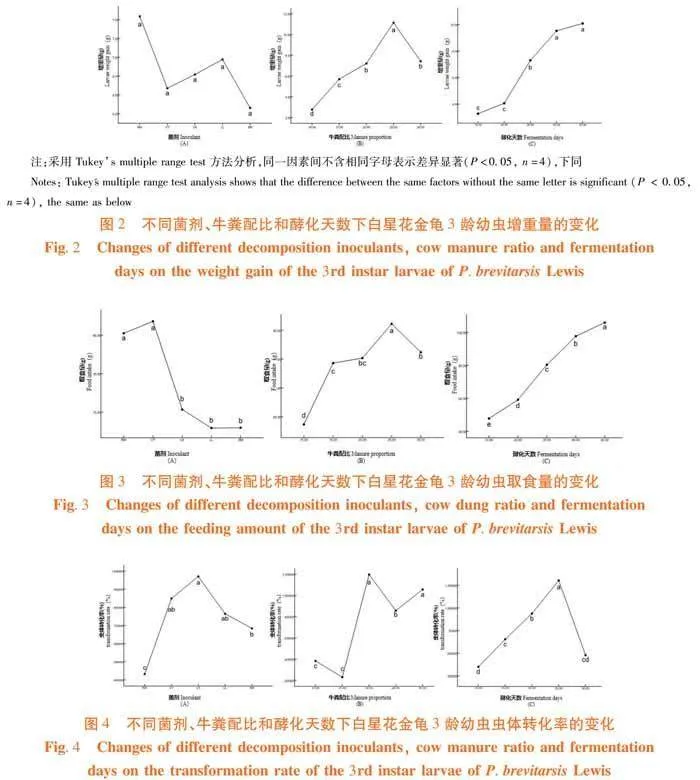
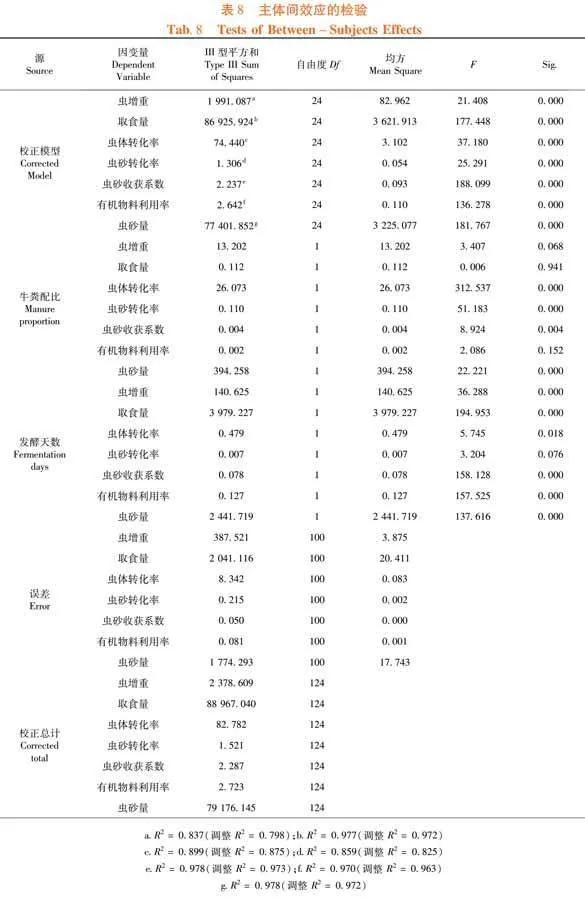
摘 要:【目的】研究白星花金龟取食葡萄枝条的高效腐解条件和转化参数优化,为葡萄枝条的资源化利用提供新路径。
【方法】以粉碎的葡萄枝条为主要原料,开展腐解菌剂、牛粪配比(%)和酵化天数(d)的3因素5水平正交试验,测定幼虫对物料的转化力,筛选并验证白星花金龟幼虫取食葡萄枝条的最优组合。
【结果】牛粪配比在第10、15、25和30 d达到显著差异水平,牛粪配比越高,其温度越高,酵化速度越好,添加菌剂和牛粪对物料的酵化有较好的促进作用;每120 g的葡萄枝条原料,辅加80 g的牛粪,添加1‰VT菌剂,发酵25 d后,获得配合饲料96 g,经白星花金龟3龄幼虫转化后,虫砂量为(77.53±22.43) g,虫体转化率(37.16%±0.04%),虫砂转化率为(84.99%±0.01%),虫砂收获系数(59.47%±0.04%),有机物料利用率在(61.17%±0.02%)。
【结论】白星花金龟3龄幼虫对发酵葡萄枝条饲料具有较好的转化力,添加1%VT菌剂、40%牛粪,酵化25 d为最佳酵化方案。
关键词:葡萄枝条;白星花金龟幼虫;腐解菌剂;生物转化;资源化利用
中图分类号:S432"" 文献标志码:A"" 文章编号:1001-4330(2024)12-3067-11
0 引 言
【研究意义】新疆是我国葡萄的主产区,种植面积均居全国首位,每年修剪产生大量葡萄枝条[1]。2020年,全国葡萄栽培面积72.62×104 hm2,新疆葡萄栽培面积12.29×104 hm2[2],占全国葡萄栽培面积的16.9%;全国葡萄产量1 431.41×104 t,新疆葡萄产量(304.90×104 t),占全国葡萄产量的21.3%。按照平均修剪枝叶干重5.25 t/hm2计算,每年输出葡萄修剪枝叶等园林废弃物约381.3×104 t[3]。因此,合理有效处理葡萄残枝,进行葡萄枝条资源化利用,使其变废为宝[4]。白星花金龟 Protaetia brevitarsis Lewis,属鞘翅目 Coleoptera,花金龟科 Cetoniidae[5]分布广泛,危害农林果业发展。白星花金龟幼虫为腐食性,可以取食自然界酵化的畜禽粪便以及沤烂的作物枝条[6-7]。通过白星花金龟幼虫转化有机废弃物的生态功能和潜力,使白星花金龟幼虫处理葡萄枝条可望成为一条新的废物资源化利用途径。
【前人研究进展】张广杰等[8]研究表明,白星花金龟幼虫转化棉秆发酵物料的能力达27.41倍,是黑水虻的近6倍,其饲料利用率(80.07%±0.65%)和虫砂转化率(84.55%±0.53%)。其饲料的产率为62.85%。白星花金龟产业发展迅猛,尤其是和微生物产业联合发展方向,具有广阔的应用前景[9]。【本研究切入点】白星花金龟转化废弃物又可产出具有高价值的昆虫蛋白及虫砂有机肥产品[10-11]。另一方面,其幼虫虫体是优质昆虫蛋白,还可被开发用于医药和畜禽饲料领域[12-16]。目前白星花金龟转化葡萄枝条的研究未见文献报道,需研究提高白星花金龟对有机废弃物的转化力方法。【拟解决的关键问题】选用白星花金龟幼虫转化效果好的牛粪作为辅料,开展腐解菌剂、牛粪比例和发酵天数的3因素5水平正交试验,优化白星花金龟对葡萄枝条的转化力,探究白星花金龟对葡萄枝条转化力的影响。
1 材料与方法
1.1 材 料
试验地选取位于新疆昌吉回族自治州(简称昌吉州)玛纳斯县包家店镇新疆农业大学玛纳斯科研基地(44°13′49″ N,86°23′3″ E)。
白星花金龟幼虫(基地自繁自育)、葡萄枝条回收混合物(玛纳斯县乐园农业发展专业合作社)、牛粪(基地周边农牧民)、菌剂、铁锹等试验材料和工具(购于石河子市老街农贸市场)。五层货架(规格1 m×0.4 m×1.8 m,购于乌鲁木齐市华凌市场)、塑料盒(38 cm×50 cm×14 cm),残渣和幼虫分离筛(38 cm×50 cm×13.5 cm,侧孔径0.8 cm×0.8 cm,底孔径1.0 cm×0.8 cm),电子天平(LT3002,常熟市天量仪器有限责任公司),电热鼓风干燥箱(北京市永光明医疗仪器有限公司),温度计等。
1.2 方 法
腐解菌剂、牛粪辅料和酵化天数3因素5水平正交试验,处理共安排31(25+6)个。表1~4
(1)每个堆体(25+6)原料总量为120 kg,腐解菌剂按照使用说明规定的量添加,调节物料含水量为(65%±5%),堆体堆成馒头状,每天记录堆体温度,每5 d翻堆1次,5点取样法,取堆体表面下方20~30 cm处的3 kg左右的物料作为样品,共计31份样品,放到冰箱冷冻保存备用。
(2)取自然解冻的31份样品,测定其物料含水量;3龄期15日龄幼虫作为供试虫源;每个养殖盒(4 L)放20头3龄幼虫,测定其重量,每个养殖盒取折干重约为200 g的鲜物料500 g,开展12 d的饲喂试验,每个处理重复5次。
(3)第13 d称量白星花金龟幼虫的增重量、取食量、虫砂量,虫砂收获系数,参考刘玉升等[17](2012)计算饲料利用率、虫砂转化率和死亡率。计算有机物料量、各处理中葡萄枝条重量以及有机物料利用率,重量均以干重计算。
虫增重(g)=取食后虫重-初始虫重;(1)
取食量(g)=取食前总干重-葡萄枝条重-残渣重;(2)
虫体转化率(%)=虫增重/(取食量-虫砂重)×100%;(3)
虫砂转化率(%)=虫砂重/(取食量-虫重)×100%;(4)
虫砂收获系数(%)=(虫砂重/总干重)×100%;(5)
有机物料利用率(%)=(取食量/有机物料量)×100%。(6)
1.3 数据处理
运用SPSS 26.0进行单因素方差分析(One-Way ANOVA),对不同处理间的差异进行Duncan多重比较分析(Plt;0.05)。应用Microsoft Excel 记录、整理数据和绘制表格,用Origin 2022作图。
2 结果与分析
2.1 三因素对各处理物料温度变化的影响
研究表明,各处理之间温度均是先急剧升高,然后随着每次的翻堆波动性下降,最高温度超过60℃,到30 d发酵结束,除对照处理外,温度均在30℃以上,高于同天平均气温。所有处理在15 d时,堆体温度均出现下降情况,但是只有对照比较明显。牛粪配比越高的,其温度越高,酵化速度越好。添加菌剂和牛粪对物料的酵化有较好的促进作用。图1
在每5 d一个发酵周期下,腐解菌剂对物料发酵温度的影响未达到显著差异水平,整体比较平稳。牛粪配比在第10、15、25和30 d达到显著差异水平,前10 d以牛粪配比为30%的温度最高,以牛粪配比为50%较低,20 d后,则呈现相反的趋势。在发酵天数上,发酵25 d时表现出显著差异水平,应是物料发酵温度的拐点。至30 d发酵结束,除CK组外,25个处理的堆体温度均在35℃以上,远高于同天环境温度。CK组前期温度较高,25 d后温度出现急剧下降的情况,25个处理的堆体温度在发酵25 d后才有一个较为明显的下降,这与物料发酵程度进入后期有关,也与环境温度较低有一定的关系(20 d后平均气温低于20℃)。添加菌剂和牛粪可以维持物料堆体温度在一个较高而平稳的范围内,进而促进葡萄枝条的发酵。表5
2.2 三因素对白星花金龟转化葡萄枝条的影响
研究表明,白星花金龟幼虫对物料的转化力数据在各处理之间差别较大,平均增重量在2.77~11.14 g,平均取食量在47.79~105.97 g,虫体转化率23.05%~72.69%,虫砂转化率为67.28%~96.06%,虫砂收获系数6.08%~59.47%,有机物料利用率在8.51%~68.71%。平均增重量、平均取食量、虫砂转化率、砂收获系数和有机物料利用率均是以第24组(菌剂、牛粪配比、酵化天数分别为LL菌剂、20%、10 d)最差;第20组(菌剂、牛粪配比、酵化天数分别为LL菌剂、40%、25 d)最优;虫体转化率第24组(菌剂、牛粪配比、酵化天数分别为LL菌剂、20%、10 d)最差,以第7组(菌剂、牛粪配比、酵化天数分别为LK菌剂、30%、25 d)最优;虫砂转化率以第24组最差,第7组最优。腐解菌剂对白星花金龟3龄幼虫的转化力,虫砂转化率和虫体转化率指标上达到显著差异水平,在其他4个指标上未达到显著差异水平,VT菌剂表现最佳。在牛粪配比上,以40%和50%表现最佳,并在取食量、虫砂量、饲料利用率和虫砂转化率指标上与10%和20%差异显著。发酵天数对白星花金龟3龄幼虫的转化力上,以25 d和30 d 2个水平表现最佳,并在取食量、虫砂量、饲料利用率3个指标上显著高于发酵15 d处理。表6
白星花金龟3龄幼虫对不同发酵天数下葡萄枝条的转化力差异较大。取食量、增重量、虫砂量指标均为发酵25 d处理最优;饲料利用率、虫砂转化率均为发酵10 d处理最优;虫体转化率为发酵20 d处理最优。纯葡萄枝条发酵25 d,白星花金龟对葡萄枝条的转化力最佳。表7
2.3 主体间效应
研究表明,白星花金龟3龄幼虫对不同发酵天数下葡萄枝条的转化力差异较大。取食量、增重量、虫砂量指标均为发酵25 d处理最优;饲料利用率、虫砂转化率均为发酵10 d处理最优;虫体转化率为发酵20 d处理最优。纯葡萄枝条发酵25 d,白星花金龟对葡萄枝条的转化力最佳。表8
2.4 直观分析和Tukey检验
研究表明,在以增重量为筛选指标时,菌剂、牛粪配比和酵化天数的最优组合为RW菌剂、牛粪配比为40%和酵化25 d。图2
在以取食量为筛选指标时,菌剂、牛粪配比和酵化天数的最优组合为VT菌剂、牛粪配比为50%和酵化25 d。图3
在以虫体转化率为筛选指标时,菌剂、牛粪配比和酵化天数的最优组合为VT菌剂(LK菌剂)、牛粪配比为30%和酵化25 d。图4
在以虫砂转化率为筛选指标时,菌剂、牛粪配比和酵化天数的最优组合为VT菌剂(LK菌剂、LL菌剂、EM菌剂)、牛粪配比为40%和酵化25 d。图5
在以虫砂收获系数为筛选指标时,菌剂、牛粪配比和酵化天数的最优组合为VT菌剂、牛粪配比为50%和酵化25 d。图6
在以有机物料利用率为筛选指标时,菌剂、牛粪配比和酵化天数的最优组合为VT菌剂(RW菌剂)、牛粪配比为40%和酵化25 d。图7
在以虫砂量为筛选指标时,菌剂、牛粪配比和酵化天数的最优组合为VT菌剂、牛粪配比为50%和酵化25 d。图8
菌剂在各项指标中,表现不一,最佳的菌剂还是VT菌剂。牛粪配比以40%最佳,但50%也表现较好。酵化天数25 d为最佳,30 d表现良好。根据7个指标和考虑尽量减少牛粪添加比例、缩短酵化天数、降低物料处理成本的原则,并参考白星花金龟3龄幼虫转化不同酵化天数的棉田残膜回收混合物的结果,综合选定3因素的最优组合为VT菌剂、牛粪比例40%和酵化天数为25 d。
3 讨 论
3.1
白星花金龟幼虫对作物秸秆和酵化的畜禽粪便均有较好的分解能力[14],玉米秸秆、平菇和大球盖菇菌糠、生活湿垃圾、腐熟沼渣、猪粪、牛粪等均可进行取食分解[18],且白星花金龟幼虫为很好的昆虫源蛋白饲料原料[19-20]。前期研究表明,相比较于猪粪、鸡粪以及尿素等,牛粪与棉秆混合,白星花金龟幼虫对其有较高的转化能力[21]。相较于之前的研究,葡萄枝条富含木质素、纤维素,且两者质量占比均在280~500 mg/g范围以内,由此葡萄枝条表现出柔韧的物理特性,针对酵化方面的关键数据进行相关的探索和研究,确定了葡萄枝条的可被白星花金龟幼虫取食最佳效果的酵化方案。
3.2
通过白星花金龟对葡萄枝条的生物转化,可辅助转化牛粪得到昆虫蛋白和虫砂[17,22-23],但是在其他农业废弃物的应用需要继续研究。白星花金龟生长周期短、繁殖力、转化力和适应性强,并且技术建设周期短、可复制、易推广[24-25]。试验中仍有葡萄枝条与牛粪粘结成块导致白星花金龟幼虫无法取食的情况出现,可能与粉碎程度和酵化的翻搅程度有关,后期可在酵化时使用机械充分翻搅堆体以尝试解决问题。
4 结 论
利用白星花金龟幼虫转化处理堆积发酵葡萄枝条具有可行性,且效果较佳。取食葡萄枝条的3龄幼虫累计增重量、虫砂量均为最佳。每120 g的葡萄枝条原料,辅加80 g的牛粪,添加1‰VT菌剂,发酵25 d后,获得配合饲料96 g,经白星花金龟3龄幼虫转化后可获得86.79 g的虫砂,虫体增重6.59 g,剩余21.85 g残渣。白星花金龟幼虫转化发酵物料的能力达23.84倍(饲料转化率(FCR)=取食量/增重量),饲料利用率(61.17%±0.02%)和虫砂转化率(81.55%±0.01%)。
参考文献(References)
[1]满保德. 新疆吐鲁番地区葡萄产业发展对策研究[D]. 石河子: 石河子大学, 2017.
MAN Baode. Research on the development strategy of grape industry in Turpan, Xinjiang[D]. Shihezi: Shihezi University, 2017.
[2] 雷天翔, 施维新, 宋敏, 等. 新疆生产建设兵团葡萄产业发展问题与对策[J]. 中国果树, 2023,(9): 117-121.
LEI Tianxiang, SHI Weixin, SONG Min, et al. Problems and countermeasures for the development of grape industry in Xinjiang Production and Construction Corps[J]. China Fruits, 2023,(9): 117-121.
[3] 杨明昊, 张艺灿, 王孝娣, 等. 葡萄枝条堆肥对设施栽培葡萄园土壤和87-1葡萄生长发育的影响[J]. 中国果树, 2023(4): 78-81, 86.
YANG Minghao, ZHANG Yican, WANG Xiaodi, et al. Effects of grape branch compost on soil and 87-1 grape growth in protected cultivation vineyard[J]. China Fruits, 2023(4): 78-81, 86.
[4] 刘文政, 平凤姣, 白雪冰, 等. 葡萄枝条资源化利用研究现状及进展[J]. 农业工程学报, 2022, 38(16): 270-283.
LIU Wenzheng, PING Fengjiao, BAI Xuebing, et al. Status and prospect of resource utilization for grape vine stalks[J]. Transactions of the Chinese Society of Agricultural Engineering, 2022, 38(16): 270-283.
[5] 张广杰. 虫菌复合技术转化棉秆还田对棉花生长发育及黄萎病发生的影响[D]. 乌鲁木齐: 新疆农业大学, 2022.
ZHANG Guangjie. Effects of conversion of cotton stalk to field by insect-bacteria composite Technology on cotton growth and development and occurrence of verticillium wilt[D] Urumqi: Xinjiang Agricultural University, 2022.
[6] 刘玉升, 骆洪义, 叶保华. 餐厨废弃物的环境昆虫处理途径及资源化利用探讨[J]. 再生资源与循环经济, 2013, 6(4): 35-37.
LIU Yusheng, LUO Hongyi, YE Baohua. The treatment and utilization approach of kitchen waste by environmental insects[J]. Recyclable Resources and Circular Economy, 2013, 6(4): 35-37.
[7] 周婷, 赵威, 赵传岳, 等. 灵芝菌糠对白星花金龟幼虫生长性能的影响[J]. 山东农业大学学报(自然科学版), 2022, 53(6): 868-873.
ZHOU Ting, ZHAO Wei, ZHAO Chuanyue, et al. Effects of the spent substrate of ganodorma lucidum on the growth performance of Protaetia brevitarsis lewis larvae[J]. Journal of Shandong Agricultural University (Natural Science Edition), 2022, 53(6): 868-873.
[8] 张广杰. 白星花金龟对有机废弃物的转化技术研究[D]. 泰安: 山东农业大学, 2019.
ZHANG Guangjie. Research on the conversion technology of organic waste by Protaetia brevitarsis[D]. Taian: Shandong Agricultural University, 2019.
[9] 张广杰, 王倩, 刘玉升. 白星花金龟人为条件生物学与应用潜力[J]. 环境昆虫学报, 2020, 42(2): 257-266.
ZHANG Guangjie, WANG Qian, LIU Yusheng. Biology under artificial condition and utilization potential of Potosia brevitarsis (Coleoptera: Cetoniidea)[J]. Journal of Environmental Entomology, 2020, 42(2): 257-266.
[10] 秦铭潞. 白星花金龟幼虫蛋白的提取、分离纯化及抗炎性研究[D]. 泰安: 山东农业大学, 2020.
QIN Minglu. Study on extraction, isolation and purification of protein from larva of the Protaetia brevitarsis and its anti-inflammatory[D]. Taian: Shandong Agricultural University, 2020.
[11] 史长旭, 张广杰, 徐业山, 等. 白星花金龟虫粪砂混配基质对黄瓜和辣椒育苗效果的影响[J]. 新疆农业大学学报, 2021, 44(6): 443-447.
SHI Changxu, ZHANG Guangjie, XU Yeshan, et al. Effects of Protaetia brevitarsis lewis larvae dung-sand mixture matrix on cucumber and pepper seedling[J]. Journal of Xinjiang Agricultural University, 2021, 44(6): 443-447.
[12] Yoon H S, Lee C S, Lee S Y, et al. Purification and cDNA cloning of inducible antibacterial peptides from Protaetia brevitarsis (Coleoptera)[J]. Archives of Insect Biochemistry and Physiology, 2003, 52(2): 92-103.
[13] Lee D G, Park J H, Shin S Y, et al. Design of novel analogue peptides with potent fungicidal but low hemolytic activity based on the cecropin A-melittin hybrid structure[J]. Biochemistry and Molecular Biology International, 1997, 43(3): 489-498.
[14] 杨诚, 刘玉升, 徐晓燕, 等. 白星花金龟幼虫资源成分分析及评价[J]. 山东农业大学学报(自然科学版), 2014, 45(2): 166-170.
YANG Cheng, LIU Yusheng, XU Xiaoyan, et al. Analysis and evaluation of resource components of Protaetia brevitarsis(lewis) larvae[J]. Journal of Shandong Agricultural University (Natural Science Edition), 2014, 45(2): 166-170.
[15] Li Y M, Fu T, Geng L L, et al. Protaetia brevitarsis larvae can efficiently convert herbaceous and ligneous plant residues to humic acids[J]. Waste Management, 2019, 83: 79-82.
[16] Manning P, Slade E M, Beynon S A, et al. Functionally rich dung beetle assemblages are required to provide multiple ecosystem services[J]. Agriculture, Ecosystems amp; Environment, 2016, 218: 87-94.
[17] 刘玉升, 张大鹏. 基于白星花金龟幼虫转化玉米秸秆的微循环农牧场模式研究[J]. 安徽农业科学, 2015, 43(31): 85-87.
LIU Yusheng, ZHANG Dapeng. Study on the model of microcirculation farm and ranch on the corn straw transformed by larval of Potosia brevitarsis lewis[J]. Journal of Anhui Agricultural Sciences, 2015, 43(31): 85-87.
[18] Zhang G J, Xu Y S, Zhang S, et al. Transformation capability optimization and product application potential of proteatia brevitarsis (Coleoptera: Cetoniidae) larvae on cotton stalks[J]. Insects, 2022, 13(12): 1083.
[19] 何笙, 周泽容, 吴赵平, 等. 白星花金龟发生与防治技术研究初报[J]. 中国农学通报, 2006, 22(6): 314-316.
HE Sheng, ZHOU Zerong, WU Zhaoping, et al. A study on the occurrence of postosia brevitarsis leiwis and its prevention amp; control technology[J]. Chinese Agricultural Science Bulletin, 2006, 22(6): 314-316.
[20] 王佳男. 基于白星花金龟幼虫活体筛选高致病力白僵菌菌株[D]. 泰安: 山东农业大学, 2019.
WANG Jianan. Screening of high-virulence strains of Beauveria bassiana based on Protaetia brevitarsis larvae[D]. Taian: Shandong Agricultural University, 2019.
[21] 郭勇. 郓城县农业有机废弃物资源调查和环保昆虫转化处理模式探究[D]. 泰安: 山东农业大学, 2020.
GUO Yong. Yuncheng County Investigation of agricultural organic waste resour-ces and exploration of Environmental protection insect transformation treatment model[D]. Taian: Shandong Agricultural University, 2020.
[22] 张倩. 取食平菇菌糠的白星花金龟生物学研究[D]. 泰安: 山东农业大学, 2015.
ZHANG Qian. Biological study of Protaetia brevitarsis feeding on oyster mush-room bran[D]. Taian: Shandong Agricultural University, 2015.
[23] 孙晨可. “小麦秸秆—大球盖菇—白星花金龟” 循环模式研究[D]. 泰安: 山东农业大学, 2018.
SUN Chenke. Study on the cycle pattern of \"wheat straw - large ball mushroom - Protaetia brevitarsis\"[D]. Taian: Shandong Agricultural University, 2018.
[24] Gossner M M, Lachat T, Brunet J, et al. Current near-to-nature forest management effects on functional trait composition of saproxylic beetles in beech forests[J]. Conservation Biology, 2013, 27(3): 605-614.
[25] Zhang X F, Wang L Y, Liu C Q, et al. Identification and field verification of an aggregation pheromone from the white-spotted flower chafer, Protaetia brevitarsis lewis (Coleoptera: Scarabaeidae)[J]. Scientific Reports, 2021, 11(1): 22362.
[26] 徐业山. 虫菌复合技术分离棉田残膜回收混合物研究[D]. 乌鲁木齐: 新疆农业大学, 2022.
XU Yeshan. Study on separation of residue film recovery mixture from cotton field by insect-bacteria composite technology[D]. Urumqi: Xinjiang Agricultural University, 2022.
Optimization of high-efficiency decomposition conditions and transformation parameters of grapevine branches eaten by the Protaetia brevitarsis Lewis
XU Andong1,ZHANG Guangjie1,FU Rao1,MENG Zhuo1,YAN Yu1, LI Baoguo2, MA Deying1
(1." Key Laboratory of Monitoring and Safety Prevention and Control of Agriculture and Forest Pests/ College of Agriculture, Xinjiang Agricultural University ,Urumqi 830052, China; Urumqi 830052, China; 2. Tianfeng Animal Husbandry Development Co., Ltd. of the 83th Regiment, the 5th Division, Jinghe Xinjiang 833303, China)
Abstract:【Objective】 Optimization of high-efficiency decomposition conditions and transformation parameters of grapevine branches eaten by the Protaetia brevitarsis Lewis,which has provided a new way for the resource utilization of grape branches.
【Methods】" Crushed grape branches were taken as the main raw materials, the orthogonal experiment of 3 factors and 5 levels was performed, which included the decomposition inoculants, the ratio of cow dung (%) and the number of fermentation days (d).By measuring the conversion power of larvae to the materials, the optimal combination of feeding grape branches by the larva was screened and verified.
【Results】" The results showed that the proportion of cow dung reached a significant difference level at the 10 th, 15 th, 25 th and 30 th days.The higher the proportion of cow dung, the higher the temperature, indicating the better fermentation rate, and the addition of decomposition inoculants and cow dung had a better promotion effect on the fermentation of materials.After fermentation for 25 days, 96 g of compound feed was obtained from each 120 g of raw grape branches, supplemented with 80g of cow dung and 1‰ VT decomposition inoculants.After the conversion of the 3rd larva, the insect sand content was (77.53±22.43)g, the insect body conversion rate was (37.16%±0.04%), and the insect sand conversion rate was (84.99%±0.01%).The harvest coefficient of insect sand was (59.47%±0.04%), and the utilization rate of organic materials was (61.17%±0.02%).
【Conclusion】" The 3rd instar larvae of the Protaetia brevitars has a good conversion ability to ferment grape branch feed.Adding 1%VT decomposition inoculants, 40% cow dung and after 25 d fermentation is the best fermentation scheme.
Key words:grape branches; larvae of Protaetia brevitarsis Lewis; decomposing inoculants; biotransformation; resource utilization
Fund projects:Shuanghe City Samp;T Project of the Fifth Division, XCPP (21XM03) ;Key Scientific R amp; D Program Project of Xinjiang Uygur Autonomous Region (2022B02046)
Correspondence author: MA Deying(1968-), female, from Urumqi, Xinjiang , professor,Ph.D.,master supervisor/doctoral supervisor, research dirction:green control of pests research, (E-mail)mdynd@163.com
基金项目:新疆生产建设兵团第五师双河市科技项目(21XM03);新疆维吾尔自治区重点研发专项(2022B02046)
作者简介:徐安东(1998-),新疆喀什人,硕士研究生,研究方向为资源昆虫及废弃物资源化利用,(E-mail)1625461918@qq.com
通讯作者:马德英(1968-),女,新疆乌鲁木齐人,教授,博士,硕士生/博士生导师,研究方向为有害生物绿色防控,(E- mail)mdynd@163.com

